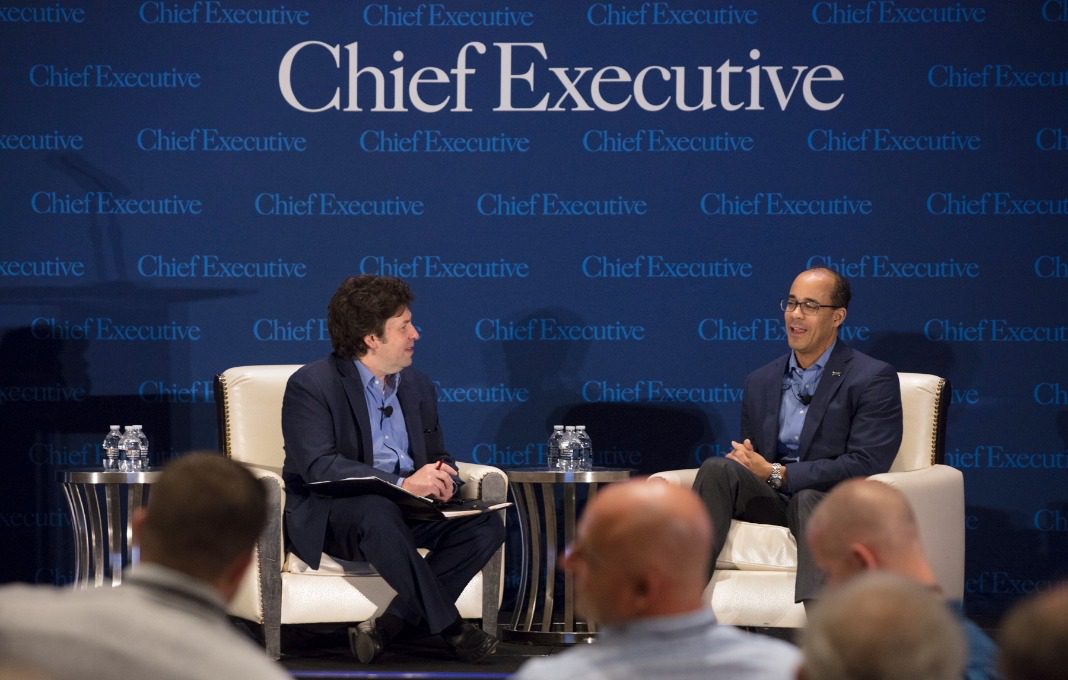Embrace the 80 Percent Solution


Consider all that manufacturing chiefs must contend with these days—continued labor shortages, rising worker demand for schedule flexibility, growing skill deficits, stubborn or new supply-chain snarls, proliferating regulations, the vagaries of an uncertain and challenging economy—and the most they should hope for in this environment is to operate their plants at about 80 percent of capacity.
That was one of the significant takeaways from CEOs, subject-matter experts and industry officials who addressed the Chief Executive Manufacturing Leadership Summit in Detroit this week. Strive as they might against all these headwinds, manufacturing leaders heard, their best strategy may be to hope for a happy workforce but to plan for a lower level of top-quality output than was their optimum before the pandemic and the other abrupt changes of the last few years.
“We have had employees come back and work for less” compensation than they could get elsewhere because “they love our culture,” Leon Wolmarans, COO of Pelco Products, told a summit breakout session on talent. The downside is that “you should probably plan to run at only 80 to 85 percent of capacity these days. You can’t run overtime and three shifts all the time [any more]. That needs an adjustment.”
Manufacturing chiefs who attended the summit at MGM Grand Casino in downtown Motor City also toured some cutting-edge factories in the area and heard advice including these highlights:
Help domesticate your suppliers. Mujeeb Ijaz, founder of EV-battery maker Our Next Energy (ONE), agreed that “onshoring” and “reshoring” are worthy pursuits for U.S. manufacturers at every level. But he said companies of all sizes must lean into the exercise to get the re-domestication of American manufacturing that will help their own cause.
“U.S. companies need to help build U.S. companies,” said Ijaz, who’s been helping scale his Michigan-based outfit to make long-range batteries that would compete with Chinese manufacturers. “If you want a supplier like ONE to exist, you have to figure out how to work with companies that are trying to build themselves up, and cultivate a balance in supply-chain development but also maintain your firm.”
That may involve “making decisions to buy [supplies] at higher prices,” he said, “but adjacent supply-chain development is a necessary thing.” Consider the manifold increase in the cost of an over-sea shipping container compared with five years ago, for instance. “Localizing manufacturing and making those decisions will give businesses reasons to [achieve] higher volume. We will have to re-industrialize or we’ll face the consequences of losing in manufacturing as a global superpower.”
Recruit your community. Manufacturers need “to be able to change misconceptions and build perceptions of what manufacturing is, and tell the story of what you do and how you do it and why it matters and how it fits into the larger landscape,” said Carolyn Lee, president and executive director of the Manufacturing Institute.
That effort needs to focus locally, she said. “Give parents and students an opportunity to understand what manufacturing is all about” through school programs, she advised. Sponsoring “the Little League team, Girl Scouts, other things, are all workforce-development opportunities, not just funds and logos and team t-shirts. Spend a few minutes with them talking about what you do and why you do it, cutting-edge technology and the new things you do and why it can be life-changing work.”
Communicate benefits. Many employees don’t know how good they have it; so make sure they do. Bridgewater Interiors, for instance, has started doing much more communication to employees about the benefits they have than earlier as part of a broader push to boost engagement of its workforce of several hundred people making automotive seats and components in four plants, including one in central Detroit.
“We have tuition reimbursement for employees, and we never canceled it, even during Covid,” said CEO Ron Hall Jr. “But newer employees didn’t even know we had it. We decided we had to do a better job of communicating things that already existed.” These efforts included Bridgewater’s CFO “getting out front in ‘town-hall’ meetings to explain the significance of our company’s match of their 401k accounts.
“So, some of that is coming back to us: We walk production floors now and employees stop me and say they appreciate those things.”
Elevate “the project.” Manoj Bhargava has reached multibillionaire status as an industrialist in part by “making the project” the boss, dictating what needs to be done and who needs to do it, rather than management via executive titles or even apparent qualifications.
“Most large-company executives are really politicians,” said the founder of 5-hour Energy and an entrepreneur who’s harnessing industrial design and manufacturing technology on a number of other planes besides dominating the energy-shot category. “Everybody in our company is a project manager. When I hire people, I say, ‘If it’s good for the project, and someone below you comes up [with a good idea] and you get mad about it, you’re out of here.’ We all work for the project. There’s no person that’s the boss; it’s the project.”
Plan automation strategically. Jerry Perez noted that a manufacturer’s “automation roadmap” or strategy “isn’t for automation—it’s for saving money, redeploying assets and so on. So the first thing you do is not figure out how to automate ‘X.’ Automate what you can justify, for example with annual savings and return on investment,” said the executive director and global accounts manager of the business-development group for Fanuc America, a leading factory-automation enterprise.
When it comes to a company’s “automation team,” Perez said, cover these roles—even if, because of the size of your company, one person will have to assume more than one of them: financial controller; purchasing chief, “who can make sure your contract documents are bulletproof;” manufacturing engineer; someone to “do lean and value streams and what will [automation] do to upstream and downstream and to information technology”; and automation engineer.
Help your “athletes.” One way to think about manufacturing workers is as “industrial athletes” and to treat them accordingly, suggested Vince Catteruccia, health-services manager for foundry operator Neenah Enterprises, where intense heat and other working conditions can be harsh.
“Pro athletes get days off and go perform for two or three hours and spend the rest of the time recovering,” he said. “Plant workers don’t do that. They work 10 or 12 hours and sometimes six days a week; one day off is not truly time to recover. They’re truly athletes. And that is a commodity that will slowly wear out if we don’t help them recover from every one of their days.
“Understand that we as humans must have the life energy to perform. You have to take that into account with [paid time off] and general fatigability.” For that and other reasons, Neenah Enterprises runs an in-house medical clinic.
Make your supply chain resilient. Building redundancy and security into your supply chain is the path to creating resilience against the kind of disaster that visited many U.S. manufacturers beginning during Covid, said Dayna Badhorn, regional president of the Americas for Avnet, a provider of electronic products and services and related logistics. This can include second-sourcing components and over-stocking critical ones, and in general balancing considerations between “just in time” and “just in case” inventory strategies.
Manufacturing chiefs also must “strengthen your supply chain” and “think about supply chain as a competitive advantage,” she said. To do so, they should “understand design choices, including critical parts. Know where your suppliers’ suppliers come from [and] know where your raw materials are coming from that go into parts. Stay connected to all of your suppliers so you can see where you have parts.”
Wade into generative AI. Most manufacturing chiefs now are at least glancing at the growing capabilities of ChapGPT and other “genAI” programs and comparing them with the company’s needs. As they do so, Pavan Muzumdar suggested using this list of “do’s” and “don’ts.”
“First, use genAI for information synthesis, comparisons and summarization,” said the chief operating officer of Automation Alley, a Detroit-area not-for-profit manufacturing-technology consortium. “Use genAI for ideation and leverage personas in doing so. Use genAI to get started on a project. Ensure you ask genAI to offer results in chunks that you as a human can verify and validate. Ask genAI to analyze its own results and take a contrarian view against itself, for a balanced viewpoint Understand that prompts, results generated by prompts and data provided to genAI in developing results should be kept confidential.”
On the other hand, Muzumdar advised, “Don’t ask genAI for factual information unless you can independently verify it. Don’t fixate on having genAI complete a project. Don’t expect genAI to be culturally or emotionally sensitive. Don’t abdicate your responsibility as the leader and ultimate arbiter of result quality. Don’t ignore privacy-conscious practices.”


0

1:00 - 5:00 pm
Over 70% of Executives Surveyed Agree: Many Strategic Planning Efforts Lack Systematic Approach Tips for Enhancing Your Strategic Planning Process
Executives expressed frustration with their current strategic planning process. Issues include:
Steve Rutan and Denise Harrison have put together an afternoon workshop that will provide the tools you need to address these concerns. They have worked with hundreds of executives to develop a systematic approach that will enable your team to make better decisions during strategic planning. Steve and Denise will walk you through exercises for prioritizing your lists and steps that will reset and reinvigorate your process. This will be a hands-on workshop that will enable you to think about your business as you use the tools that are being presented. If you are ready for a Strategic Planning tune-up, select this workshop in your registration form. The additional fee of $695 will be added to your total.

2:00 - 5:00 pm
Female leaders face the same issues all leaders do, but they often face additional challenges too. In this peer session, we will facilitate a discussion of best practices and how to overcome common barriers to help women leaders be more effective within and outside their organizations.
Limited space available.

10:30 - 5:00 pm
General’s Retreat at Hermitage Golf Course
Sponsored by UBS
General’s Retreat, built in 1986 with architect Gary Roger Baird, has been voted the “Best Golf Course in Nashville” and is a “must play” when visiting the Nashville, Tennessee area. With the beautiful setting along the Cumberland River, golfers of all capabilities will thoroughly enjoy the golf, scenery and hospitality.
The golf outing fee includes transportation to and from the hotel, greens/cart fees, use of practice facilities, and boxed lunch. The bus will leave the hotel at 10:30 am for a noon shotgun start and return to the hotel after the cocktail reception following the completion of the round.